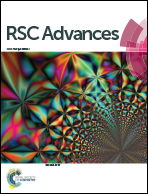Synthesis of Fe3O4/P(St-AA) nanoparticles for enhancement of stability of the immobilized lipases
Abstract
Core–shell Fe3O4/P(St-AA) (Fe3O4/polystyrene–poly acrylic acid) nanoparticles modified with carboxylic acid groups were synthesized and employed as magnetic carriers for Candida rugosa lipase (CRL) and porcine pancreas lipase (PPL) immobilization. The loading amount of CRL on the Fe3O4/P(St-AA) nanoparticles was calculated to be 87.7 mg protein per g particles. Effects of solution pH and reaction temperature on the relative activity of immobilized CRL were measured and compared with the free CRL. The hydrolytic kinetics of the free and immobilized CRL was also investigated. Hydrolytic activity tests indicated that the stability of the immobilized CRL was strengthened. It should be mentioned that the immobilized CRL retained more than 56.1% of its initial activity after reuse 10 times. Most importantly, the immobilized PPL can tolerate organic media and maintain high esterification activity in n-hexane solution. This work provided a facile and general approach to synthesize magnetic functional nanocomposites for applications in biological and biocatalytic fields.


 Please wait while we load your content...
Please wait while we load your content...